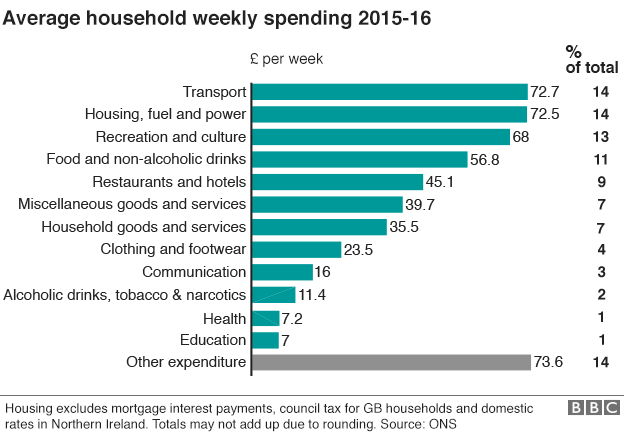ONS figures show UK spending less on alcohol and tobacco
- Published

Families in the UK are becoming more clean-living, with less money being spent on cigarettes and alcohol, but more being spent on going out to restaurants.
But the Family Spending Survey, external from the Office for National Statistics shows little change in spending overall.
In the year to the end of March 2016, families spent an average of £528.90 a week, the same as the previous year.
The ONS said growth in consumer confidence had levelled off in 2015-16.
The figures show that spending on alcohol and cigarettes continued to fall over the period, to £11.40 a week.
At the start of the 2000s, families were typically spending nearly £20 a week on such items.
Housing
Meanwhile, households spent £45 a week on going out to restaurants, cafes and hotels - the first time that figure has has been reached in five years.
This includes alcoholic drinks being consumed in pubs.

Transport and housing remain the most expensive items in the household budget.
Families spent an average of £72.70, or 14% of their budgets, on transport.
We spent more on buying cars, but less on fuel, which became cheaper.
The next biggest expense was housing.
Excluding mortgages and council tax, we spent an average of £72.50 a week on our homes.
That includes rent, heating, water and maintenance charges.
Mobile phones
The figures show big regional variations in spending on alcohol and tobacco.
Households in Scotland spent an average of £8.90 a week on alcohol, compared to £7.80 in the UK as a whole.
Scots drink considerably more spirits and liqueurs than other Britons, the figures show.
Expenditure on cigarettes is even more varied. Families in England spend just £2.90 a week on tobacco, while those in Wales spend £3, those in Scotland spend £4.90 and those in Northern Ireland spend £6.60.

Families also continue to spend more on communications - with an average of £16 a week being spent on phones and postal services.
In all, 95% of families in the UK own a mobile phone, the same proportion that have central heating.